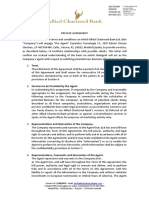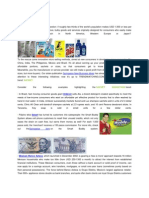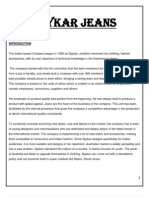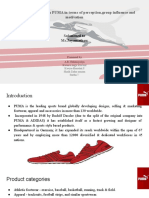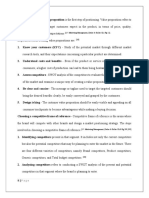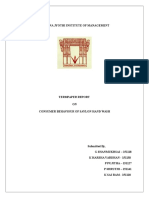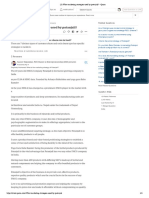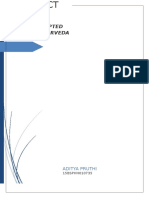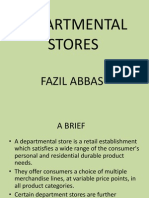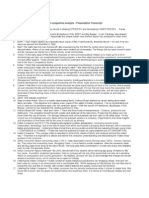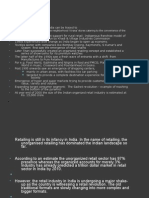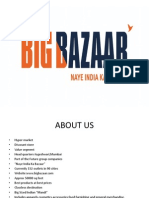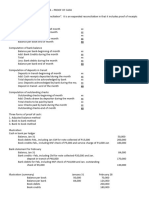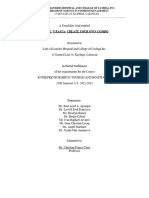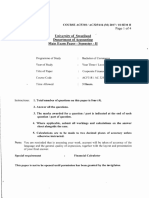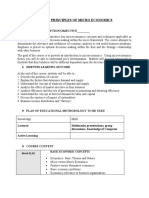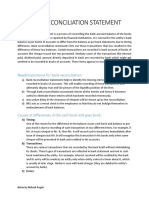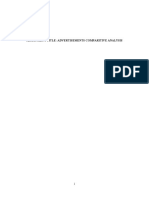0 ratings0% found this document useful (0 votes)
453 viewsSachet Marketing
Sachet Marketing
Uploaded by
Tom JohnSachet marketing is an innovative strategy aimed at low-income consumers in developing economies. It involves selling products or services in affordable small portions or sizes so more buyers can access the brand. Examples include Unilever selling low-cost detergent in Brazil, a telecom selling phones to village women in Bangladesh, and financial institutions providing microloans and rural banking access. As sachet marketing grows, packaging innovations allow products to be dispensed conveniently from single-use sachets with brand advertising on the packaging. Selling in small volumes but to many customers can open new markets while still generating profits and establishing brand awareness for future growth.
Copyright:
Attribution Non-Commercial (BY-NC)
Available Formats
Download as PPTX, PDF, TXT or read online from Scribd
Sachet Marketing
Sachet Marketing
Uploaded by
Tom John0 ratings0% found this document useful (0 votes)
453 views7 pagesSachet marketing is an innovative strategy aimed at low-income consumers in developing economies. It involves selling products or services in affordable small portions or sizes so more buyers can access the brand. Examples include Unilever selling low-cost detergent in Brazil, a telecom selling phones to village women in Bangladesh, and financial institutions providing microloans and rural banking access. As sachet marketing grows, packaging innovations allow products to be dispensed conveniently from single-use sachets with brand advertising on the packaging. Selling in small volumes but to many customers can open new markets while still generating profits and establishing brand awareness for future growth.
Original Description:
sachet marketing ppt
Copyright
© Attribution Non-Commercial (BY-NC)
Available Formats
PPTX, PDF, TXT or read online from Scribd
Share this document
Did you find this document useful?
Is this content inappropriate?
Sachet marketing is an innovative strategy aimed at low-income consumers in developing economies. It involves selling products or services in affordable small portions or sizes so more buyers can access the brand. Examples include Unilever selling low-cost detergent in Brazil, a telecom selling phones to village women in Bangladesh, and financial institutions providing microloans and rural banking access. As sachet marketing grows, packaging innovations allow products to be dispensed conveniently from single-use sachets with brand advertising on the packaging. Selling in small volumes but to many customers can open new markets while still generating profits and establishing brand awareness for future growth.
Copyright:
Attribution Non-Commercial (BY-NC)
Available Formats
Download as PPTX, PDF, TXT or read online from Scribd
Download as pptx, pdf, or txt
0 ratings0% found this document useful (0 votes)
453 views7 pagesSachet Marketing
Sachet Marketing
Uploaded by
Tom JohnSachet marketing is an innovative strategy aimed at low-income consumers in developing economies. It involves selling products or services in affordable small portions or sizes so more buyers can access the brand. Examples include Unilever selling low-cost detergent in Brazil, a telecom selling phones to village women in Bangladesh, and financial institutions providing microloans and rural banking access. As sachet marketing grows, packaging innovations allow products to be dispensed conveniently from single-use sachets with brand advertising on the packaging. Selling in small volumes but to many customers can open new markets while still generating profits and establishing brand awareness for future growth.
Copyright:
Attribution Non-Commercial (BY-NC)
Available Formats
Download as PPTX, PDF, TXT or read online from Scribd
Download as pptx, pdf, or txt
You are on page 1of 7
“SACHET MARKETING”
--A BRIEF OVERVIEW
TOPICS TO BE COVERED
• INTRODUCTION
• SUCCESSFUL SACHET MARKETING TRENDS
• IMPLEMENTATION OF SACHET MARKETING IN
FINANCIAL SECTOR
• PACKAGING OF SACHETS
• CONCLUSION OF SACHET MARKETING
INTRODUCTION
• IF roughly two-thirds of the world's population makes USD 1,500 or
less per year, why try to sell them expensive, bulky goods and
services originally designed for consumers who easily make twenty
times as much in North America, Western Europe or Japan?
To the rescue come innovative micro-selling methods, aimed at
new consumers in developing mega-economies like China, India,
The Philippines, Mexico and Brazil. It's all about serving up your
products, services and loans in affordable portions, sachets or sizes,
so that consumers get to know and like your brand.
Meanwhile, you the manufacturer or service provider can still
make a good profit from sheer overall volume (smaller sizes, but
more buyers)
SUCCESFUL SACHET MARKETING TRENDS
• IN BRAZIL UNILEVER SOLD LOW COST DETERGENT ALA FOR
LOW INCOME GROUP
• FILIPINO TELECO PEOPLE SMART HAVE SUCCEFULLY TURNED
THIER CUSTOMER INTO SALES PERSON.
• GRAMEEN PHONE BANGLADESH CELL PHONE OPERATOR
INTRODUCED PHONES TO VILLAGE LADY SCHEME.
• MICROSOFT INTRODUCED THE XP LITE A LOW COST
EDITION.
• SYMANTEC LAUNCHED LOW COST EDITION OF ANTI VIRUS.
IMPLEMENTATION OF SACHET MARKETING
IN FINANCIAL SECTOR
• Micro finance groups like Weetu of U.K provided
micro finance to women.
• India's ICICI Bank built the first rural ATM to serve
micro-savers .
• Citi group of india intoduced online account for
small savers
• Bradesco, Brazil's private bank, to set up very basic teller
services in underused post offices.
PACKAGING OF SACHETS
With SACHET MARKETING innovations taking off, it will
come as no surprise that the sachet itself is ready for
innovation too. Check out Snap! International and Snap
Pak, two companies that provide packaging of sachet
products and a unique new advertising medium. The
units are designed to open and dispense the product
with a two-fingered snap-and-squeeze (rather than
cutting or tearing). In addition to more convenience, one
side of the packaging can be printed with high-
resolution, photographic quality artwork.
CONCLUSION
• Thinking small in large volumes -- the essence of SACHET
MARKETING -- yet never losing brand focus, could open
up entirely new markets for many of the worlds B2C and
B2B manufacturers and service providers. If your
customers are willing but cash strapped, think micro
loans, think mini-sizes, think leasing, think bundling, think
reselling! It will make you money, and lay the foundation
for brand awareness with future affluent customers. And
as the microfinance and Whirlpool examples show, some
of the thinking may eventually translate in innovative
products for mature markets as well.
You might also like
- Porfolio of Evidence - Guide - US 116363 THERESADocument104 pagesPorfolio of Evidence - Guide - US 116363 THERESATheresa MoonsamyNo ratings yet
- Agent Agreement ACB - Espatelco Tecnologia S.LDocument6 pagesAgent Agreement ACB - Espatelco Tecnologia S.LR. Bidaurreta100% (1)
- Application - of - Economic - Concepts-Activity - 2 KATRINA AMORE VINARAODocument7 pagesApplication - of - Economic - Concepts-Activity - 2 KATRINA AMORE VINARAOKatrina Amore VinaraoNo ratings yet
- Can Nescafe, Maggi, Kitkat Dig Deeper Into India? Nestle Is Mapping Culture Clusters To Crack ItDocument3 pagesCan Nescafe, Maggi, Kitkat Dig Deeper Into India? Nestle Is Mapping Culture Clusters To Crack ItROHIT CHOUDHARYNo ratings yet
- Case Study by Nafis mkt460Document6 pagesCase Study by Nafis mkt460Md. Mahir Shahriar Rabbi 1812837630100% (1)
- Assignment For Topic 01-01: Productivity and CostDocument3 pagesAssignment For Topic 01-01: Productivity and Costsyed aliNo ratings yet
- Sachet Marketing in IndiaDocument54 pagesSachet Marketing in IndiaAmit JodawatNo ratings yet
- Sachet MarkettingDocument19 pagesSachet MarkettingSujesh KhareNo ratings yet
- Licious - Pitch DeckDocument27 pagesLicious - Pitch Deckreadbooks129No ratings yet
- BMC Case Study - Vikram V - 18020848018 PDFDocument7 pagesBMC Case Study - Vikram V - 18020848018 PDFVikram VaidyanathanNo ratings yet
- Gujarat Technological UnversityDocument2 pagesGujarat Technological UnversityKrutika Goyal100% (1)
- Brand Yatra StayfreeDocument20 pagesBrand Yatra StayfreeJosine Jones100% (1)
- Literature Review: Shreya Jain PGDM-0025Document5 pagesLiterature Review: Shreya Jain PGDM-0025jini jainNo ratings yet
- BATA CompanyDocument18 pagesBATA CompanyMahadev ChunarNo ratings yet
- Spykar JeansDocument6 pagesSpykar Jeansshjvd72100% (1)
- Entrepreneurship ProjectDocument11 pagesEntrepreneurship ProjectHimungshu Kashyapa100% (2)
- A Writeup On SevenDocument5 pagesA Writeup On Sevenabhishek kunalNo ratings yet
- ColgateDocument32 pagesColgategargatworkNo ratings yet
- Project On Lakme LipstickDocument69 pagesProject On Lakme Lipsticksairushika0No ratings yet
- Consumer Research On PUMA in Terms of Perception, Group Influence and MotivationDocument24 pagesConsumer Research On PUMA in Terms of Perception, Group Influence and MotivationSneha Venkat99100% (1)
- Marketing Strategies of Britannia by Subharth SahaDocument21 pagesMarketing Strategies of Britannia by Subharth Sahasubharth saha43% (7)
- Market Size of Salon IndustryDocument6 pagesMarket Size of Salon IndustryYash GoyalNo ratings yet
- MedimixDocument2 pagesMedimixKomal MishraNo ratings yet
- Dabur ImDocument21 pagesDabur ImRanak TrivediNo ratings yet
- Investment ProjectDocument28 pagesInvestment ProjectYashi100% (1)
- Assessingg A New Ventures Fin StrengthDocument35 pagesAssessingg A New Ventures Fin Strengthrizwanriz78No ratings yet
- Project On IPO of Cafe Coffee DayDocument45 pagesProject On IPO of Cafe Coffee DayVinit Dawane100% (1)
- A Comparative Study and Analysis of Unit Linked: Insurance Plans (Ulips) - An Idbi Fortis PerspectiveDocument81 pagesA Comparative Study and Analysis of Unit Linked: Insurance Plans (Ulips) - An Idbi Fortis PerspectiveDIWAKAR SHARMANo ratings yet
- Pharma Distribution System IndiaDocument24 pagesPharma Distribution System IndiaSgk SrikanthNo ratings yet
- Just in 10 Minutes: A Case Study On Zepto: Keywords: Zepto, Start-Up, E-Commerce, Business Model, Post-CovidDocument4 pagesJust in 10 Minutes: A Case Study On Zepto: Keywords: Zepto, Start-Up, E-Commerce, Business Model, Post-CovidAlisha ShwetaNo ratings yet
- JiomartDocument4 pagesJiomartAJITH CHANDRA GOPUNo ratings yet
- SavlonDocument10 pagesSavlonkodali harshaNo ratings yet
- Rooh e Afza Marketing ProjectDocument18 pagesRooh e Afza Marketing ProjectOsman QadirNo ratings yet
- Bisleri Tonic WaterDocument13 pagesBisleri Tonic WaterHitesh DudaniNo ratings yet
- Capitaltwo RISHABHDocument36 pagesCapitaltwo RISHABHSaloni SharmaNo ratings yet
- What Marketing Strategies Used by Patanjali?: 5 AnswersDocument4 pagesWhat Marketing Strategies Used by Patanjali?: 5 Answerskarthikk09101990No ratings yet
- Model 3 Cett ReportDocument58 pagesModel 3 Cett Reporthinduja987No ratings yet
- Big BazarDocument62 pagesBig BazarVenki GajaNo ratings yet
- Sun Silk Gang of GirlsDocument17 pagesSun Silk Gang of GirlsSakshi GuptaNo ratings yet
- Project Report Submitted in Partial Fulfilment of The Requirement For The Degree ofDocument63 pagesProject Report Submitted in Partial Fulfilment of The Requirement For The Degree ofChandan RaiNo ratings yet
- Final Cavin Kare Project 2007Document63 pagesFinal Cavin Kare Project 2007Arun KushwahaNo ratings yet
- Patanjali Ayurvedic - DataDocument15 pagesPatanjali Ayurvedic - DataSatyam Acharya100% (1)
- Dissertation For Organic Food IBNDocument79 pagesDissertation For Organic Food IBNHelloprojectNo ratings yet
- Sarvajal:Water For All: Group 3Document6 pagesSarvajal:Water For All: Group 3RALLAPALLI VISHAL VIJAYNo ratings yet
- Topic - Develop BCG Matrix On Unilever ProductsDocument15 pagesTopic - Develop BCG Matrix On Unilever Productsraj vardhan agarwalNo ratings yet
- FMCG BrandDocument17 pagesFMCG BrandRamneet ParmarNo ratings yet
- Executive SummaryDocument101 pagesExecutive SummaryMikaella JonaNo ratings yet
- Sip Report NJ 2016Document37 pagesSip Report NJ 2016vicky rajputNo ratings yet
- Presentation 1Document14 pagesPresentation 1smriti thukralNo ratings yet
- Brand Extension For BisleriDocument16 pagesBrand Extension For BisleriPratik SoniNo ratings yet
- Surf ExcelDocument77 pagesSurf ExcelSubramanya DgNo ratings yet
- Big Bazaar Vs Reliance MartDocument5 pagesBig Bazaar Vs Reliance MartMalvika Mehra100% (1)
- Vicco ProfileDocument11 pagesVicco Profilereddyraj520No ratings yet
- Business Orientation ProjectDocument29 pagesBusiness Orientation ProjectMahak Gupta Student, Jaipuria LucknowNo ratings yet
- Marketing Plan PowerpointDocument26 pagesMarketing Plan Powerpointchen3000No ratings yet
- Consumer Behavior of KurkureDocument8 pagesConsumer Behavior of Kurkureif u can't, who can100% (1)
- Apollo Tyres Equity Research ReportDocument15 pagesApollo Tyres Equity Research ReportPuneet GirdharNo ratings yet
- Muscle RDXDocument3 pagesMuscle RDXRohan SinghNo ratings yet
- A Study of Brand Awareness and Consumer Perception Towards Saffola Fittify and Cocosoul ProductsDocument20 pagesA Study of Brand Awareness and Consumer Perception Towards Saffola Fittify and Cocosoul ProductsAbhishek guptaNo ratings yet
- Departmental Stores: Fazil AbbasDocument26 pagesDepartmental Stores: Fazil Abbassivakulanthay5195No ratings yet
- Wal Mart and BIG BAZAAR: A Comparitive Analysis - Presentation TranscriptDocument2 pagesWal Mart and BIG BAZAAR: A Comparitive Analysis - Presentation TranscriptRohit SinghNo ratings yet
- The Emergence of The Neighborhood Kirana' Stores Catering To The Convenience of The ConsumersDocument36 pagesThe Emergence of The Neighborhood Kirana' Stores Catering To The Convenience of The Consumersch4509No ratings yet
- Retail Research Paper TopicsDocument5 pagesRetail Research Paper Topicsfvf2nnj9100% (1)
- Big BazaarDocument24 pagesBig BazaarSania BalwaNo ratings yet
- A Note On Price DiscriminationDocument2 pagesA Note On Price DiscriminationSUSHMITA RATHORE Student, Jaipuria IndoreNo ratings yet
- Value Added TaxDocument4 pagesValue Added TaxAllen KateNo ratings yet
- Lecture No.3 Proof of CashDocument2 pagesLecture No.3 Proof of Cashdelrosario.kenneth996No ratings yet
- Effect of Online Advertisement On Consumer Buying Behaviour-A ReviewDocument11 pagesEffect of Online Advertisement On Consumer Buying Behaviour-A Reviewamit jangraNo ratings yet
- FinalfeasibDocument20 pagesFinalfeasibAlvarez, Ara Bea JoyNo ratings yet
- 1Q 2020 PORT Nusantara+Pelabuhan+Handal+Tbk PDFDocument88 pages1Q 2020 PORT Nusantara+Pelabuhan+Handal+Tbk PDFTuýtuýNo ratings yet
- Reviewer in GBRC PRELIMDocument2 pagesReviewer in GBRC PRELIMJhernel SuaverdezNo ratings yet
- Acf 318 M 2018Document4 pagesAcf 318 M 2018Bulelwa HarrisNo ratings yet
- EN - 840Dsl CE Conformity 0408 - 2019-03Document26 pagesEN - 840Dsl CE Conformity 0408 - 2019-03NhatQuangNguyen0% (1)
- Niche Tourism - Group PresentationDocument17 pagesNiche Tourism - Group Presentationlinh nguyenNo ratings yet
- Principles of Micro EconomicsDocument3 pagesPrinciples of Micro EconomicsAbeer PervaizNo ratings yet
- Withdrawal SlipDocument3 pagesWithdrawal SlipSufmpc SanguitNo ratings yet
- Chapter 11Document10 pagesChapter 11Ms VampireNo ratings yet
- 5f388b962f84e - BANK RECONCILIATION STATEMENT PDFDocument4 pages5f388b962f84e - BANK RECONCILIATION STATEMENT PDFYogesh ChaulagaiNo ratings yet
- TRẦN THỊ MINH ANH-31231023215-23C1BUS50307014-Tiểu luận cuối kỳ môn Marketing căn bảnDocument22 pagesTRẦN THỊ MINH ANH-31231023215-23C1BUS50307014-Tiểu luận cuối kỳ môn Marketing căn bảnhieuluu.31221023224No ratings yet
- Assignment Title: Advertisements Comparitive AnalysisDocument6 pagesAssignment Title: Advertisements Comparitive AnalysisI AbramNo ratings yet
- Business Conversation Pocari Sweat VS Pocari Ion WaterDocument3 pagesBusiness Conversation Pocari Sweat VS Pocari Ion WaterMarlita AuliyahNo ratings yet
- Ella Scott Resume 5Document2 pagesElla Scott Resume 5api-619332616No ratings yet
- SAP SD Consultant: Y. Ajay KumarDocument4 pagesSAP SD Consultant: Y. Ajay KumarAjay YeluriNo ratings yet
- Introduction and Brief History of Fund (Read Deligently)Document2 pagesIntroduction and Brief History of Fund (Read Deligently)አረጋዊ ሐይለማርያምNo ratings yet
- Lesson 2.4 Implemenation of PlansDocument5 pagesLesson 2.4 Implemenation of PlansIrah Joy E. SolisNo ratings yet
- Daycare Center Sample ProposalDocument7 pagesDaycare Center Sample ProposalSamuel Girma100% (1)
- Concept of Firm and IndustryDocument9 pagesConcept of Firm and IndustryShweta SharmaNo ratings yet
- Link and Name of Facebook Posts..Document1,066 pagesLink and Name of Facebook Posts..satya beheraNo ratings yet
- Comilla University: Department of Management StudiesDocument4 pagesComilla University: Department of Management StudiesAbul Hasnat EmonNo ratings yet
- General BankingDocument43 pagesGeneral BankingGolpo MahmudNo ratings yet

